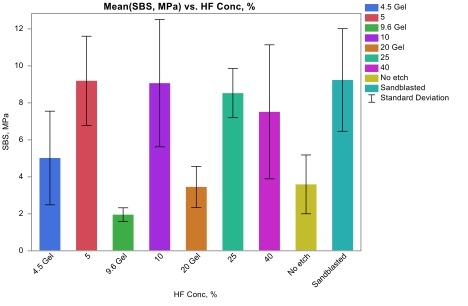IADR Abstract Archives
The Effect of Zirconia Hydrofluoric Etching Conditions on Bonding Strength
Objectives: Zirconia has become a popular ceramic in dentistry due to its overall superior toughness and wear resistance. Bonding to zirconia has posed a problem because it is an inert material. Our study focuses on the effect of hydrofluoric acid etching conditions on the sheer bond strength of resin cement to zirconia.
Methods: With an in vitro experimental design, a total of 94 sections(2mm thickness, 17.8mm width, 19.2mm height) of rectangular zirconia plates(KATANA Zirconia Blocks 14Z / STML A2) were treated using a variety of hydrofluoric (HF) concentrations and conditions. The HF etchants are 4.5% HF Gel (Vita), 9.6% Porcelain Etch Gel (Pulpdent),and lab made 20% HF Gel, and 5%. 10%, 25% and 40% HF solution, and air-bone particle abrasion (APA) groups. Several control specimens were not treated with etchant or APA. The zirconia specimens were primed with Monobond plus (Ivoclar) and bonded to Multilink Automix NG Cement (Ivoclar) rod with 3.5 mm diameter using Ultradent shear bond strength jig. The specimens were then tested for shear bond strength using Instron 5566A with a 1 kN load cell at 1 mm/min cross head speed.
Results: The bonding strengths in Table 1 and Figure 1 show the effects of different treatment conditions. Treatments with gel did not yield significant shear bond strength increases compared to the control. Etching with liquid solutions of HF showed increase in shear bond strength compared to the control. Sandblasted specimens showed increase bond strength compared to the control.
Conclusions: Etching with liquid solutions increased shear bond strengths to a level comparable to the traditional sandblasted specimens. Etching time did not have an impact on shear bond strength. Etching with gel solutions of HF did not result in increased shear bond strengths. Etching zirconia with a liquid solution of HF may be an alternative to sandblasted zirconia to improve shear bond strength.
Methods: With an in vitro experimental design, a total of 94 sections(2mm thickness, 17.8mm width, 19.2mm height) of rectangular zirconia plates(KATANA Zirconia Blocks 14Z / STML A2) were treated using a variety of hydrofluoric (HF) concentrations and conditions. The HF etchants are 4.5% HF Gel (Vita), 9.6% Porcelain Etch Gel (Pulpdent),and lab made 20% HF Gel, and 5%. 10%, 25% and 40% HF solution, and air-bone particle abrasion (APA) groups. Several control specimens were not treated with etchant or APA. The zirconia specimens were primed with Monobond plus (Ivoclar) and bonded to Multilink Automix NG Cement (Ivoclar) rod with 3.5 mm diameter using Ultradent shear bond strength jig. The specimens were then tested for shear bond strength using Instron 5566A with a 1 kN load cell at 1 mm/min cross head speed.
Results: The bonding strengths in Table 1 and Figure 1 show the effects of different treatment conditions. Treatments with gel did not yield significant shear bond strength increases compared to the control. Etching with liquid solutions of HF showed increase in shear bond strength compared to the control. Sandblasted specimens showed increase bond strength compared to the control.
Conclusions: Etching with liquid solutions increased shear bond strengths to a level comparable to the traditional sandblasted specimens. Etching time did not have an impact on shear bond strength. Etching with gel solutions of HF did not result in increased shear bond strengths. Etching zirconia with a liquid solution of HF may be an alternative to sandblasted zirconia to improve shear bond strength.

